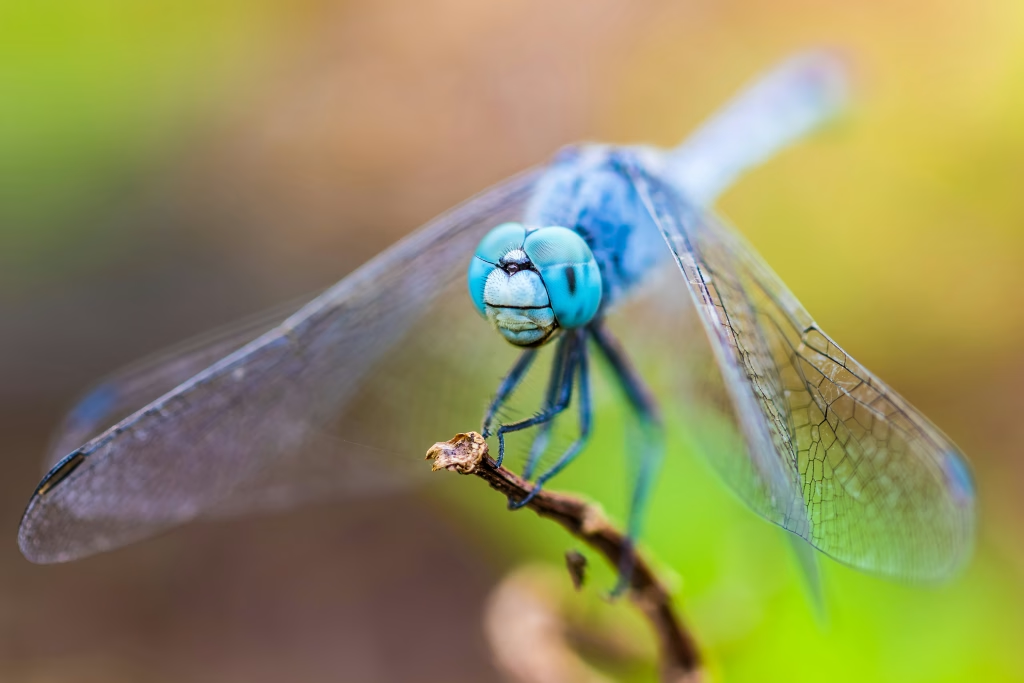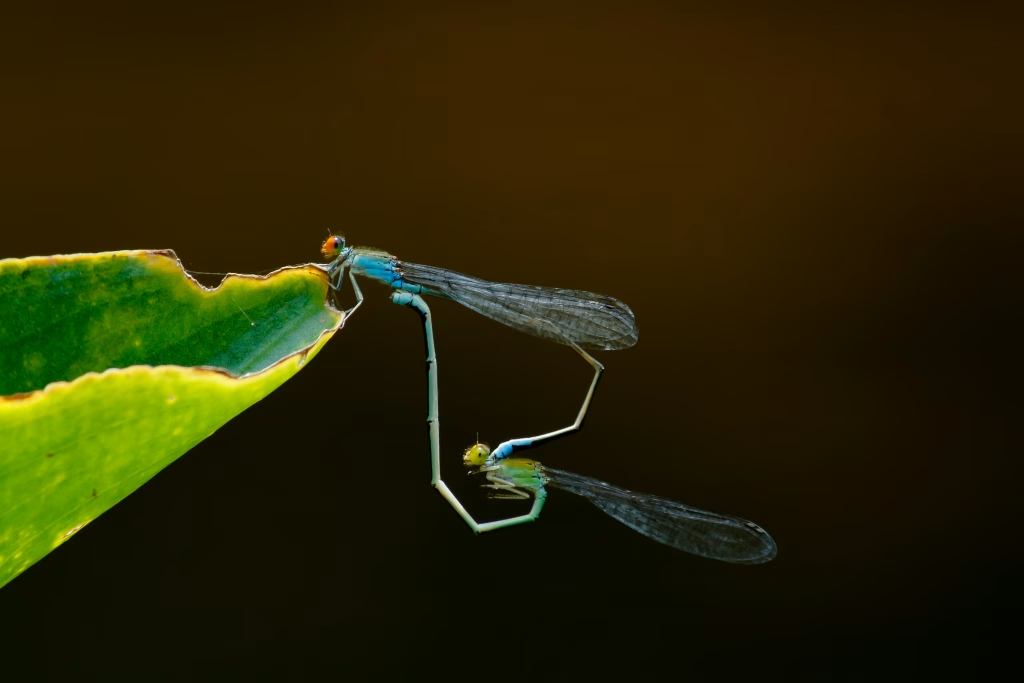Rewilding Species of the Month: Dragonflies

“There Be Dragons Everywhere. They might not all have scales and forked tongues, but they Be Here all right, grinning and jostling and trying to sell you souvenirs.” Terry Pratchett
In the Summertime, when the sun is out and there is no rain to keep them hiding away, you may be lucky enough to catch the flash of a dragonfly darting across a wetland, along a riverbank, or even flitting about your garden. You might not realise that they have crossed millions of years to be here with you and could have crossed continents too! Even without the knowledge of how brilliant they are, their presence still brings us lots of joy. The Wild Card team can testify to this: one of the highlights of our visit to the Moor Barton rewilding project was when we entered a newly created wetland area and were met with a flurry of odonata activity (dragonflies and damselflies). It was a sign that this is truly a landscape that is working for nature.
Are we slaying the dragonflies?
Dragonfly larvae are incredibly sensitive to pollutants, so their presence is a sign of a healthy wetland ecosystem. This makes them a valuable indicator species. Unfortunately, it also means that humans can easily have a detrimental impact on dragonfly populations. Fertilizer, livestock waste, and sewage overflow all upset the nutrient balance of our wetlands and result in low oxygen levels within the water. This affects not only dragonfly larvae but also other life within the ecosystem. Not only this, but microplastics, now prevalent in water ways, can be accidentally ingested by larvae, negatively impacting their nervous system.
Our actions impact dragonflies in other ways too. Adult dragonflies are big eaters, consuming 20% of their body weight each day. Unfortunately, collapse in insect populations, sometimes referred to as insectageddon, makes it harder for dragonflies to meet their dietary needs.
A further threat to our dragonflies is climate change. Warmer temperatures have meant some regions in the UK see more species heading their way. However, periods of drought, heavy rainfall, extreme weather, and coastal flooding are all putting habitats at risk. Warmer conditions both in the water and outside of it are also limiting some species’ ability to breed, grow and forage. Whilst it may currently be possible for dragonflies to survive by extending their range to more upland or northerly areas, what happens when these places continue to warm and there is nowhere left to go?
Internationally, the picture is bleak. In 2021, the IUCN found that the number of endangered red list dragonfly species had topped 40,000 for the first time. This is not only due to climate change but also thanks to habitat loss as more wetlands are drained and destroyed to make way for agriculture and infrastructure.
The need to protect our wetlands and our water quality is therefore clear.
Enter the Dragon(fly)
Though the future for dragonflies is uncertain, their past is certainly epic. Before there were other mammals, before even dinosaurs existed (a staggering 300 million years ago) there was the dragonfly’s ancestor Maganeura. Thought to be one of the first things to ever take wing and fly, maganeura is also one of the largest flying insects ever known to have existed, with a wingspan of about 71 centimetres.
Today’s dragonflies might not be so imposing in their proportions, but their long evolutionary history has led to some unique and impressive adaptations. Possessing incredible powers of flight and sight, few predators can equal their success rate.
Dragonflies are some of the strongest flyers in the insect world, reaching speeds of up to 30 miles an hour, enabling them to suddenly bring down their prey. Some species have the strength to spend most of the day on the wing and cover thousands of kilometres in their lifetime. Whilst most of our own species are born and bred in the UK, for others, such wing-power means that they may have travelled from as far away as sub-Saharan Africa.
For other dragonfly species, technique rather than brute strength provides advantage. Their wing venation is different, allowing them to bend and manoeuvre around obstacles. They also deploy direct flight muscles for independent wing movement making for impressive twists and turns. They can even fly backwards and upside down!
These flying skills combine with exceptional eyesight. Thanks to their large, multifaceted eyes, dragonflies have almost 360-degree vision and they can process images more quickly – seeing 200 images per second (for context, humans see just 60). 80% of their brain power is given over to sight and three-dimensional spatial awareness such that they can estimate the speed and trajectory of the things around them. This means they don’t have to rely on just chasing after their prey and running them down: instead, they can intercept them. With their fierce dragon-like strength, power and intelligence, the midges don’t stand a chance!
Is it any wonder then that Samurai warriors honoured the power, vigilance and skill of the dragonfly and incorporated dragonfly design into their armour and emblems?
Souvenirs from folklore
Japanese military garb is not the only dragonfly souvenir from human history. The symbolism and folklore of dragonflies is everywhere: although whether in shades of dark or light, depends upon where in the world you are.
In Europe, traditional dragonfly names do not quite imbue the honour of the Eastern traditions. Whether they are a devil’s darning needle, a devil’s steelyard, or a devil horse, their associations are far less salubrious. Though the dragonfly tail is used for love rather than harm, its similarity to a darning needle led to warnings that dragonflies would sew up your eyes if you fell asleep by a river or sew up the mouths of children if they were naughty. The Scandinavian devil’s steelyard on the other hand references a Roman weighing scale and the lore that the devil used dragonflies to weigh human souls. The association between the dragonfly and the horse is perhaps more understandable since they were often observed together. Some took them to be riding on the horse, others took them to be attacking them but, in reality, the dragonfly would be hanging around horses to predate the smaller flies and mosquitos that would be plaguing them. They were, in fact, performing a kindness rather than behaving devilishly.
Chinese symbolism, on the other hand, takes a wider look at the life cycle and behaviour of dragonflies. Observing the change from the dull coloured larvae lurking in the dark substrate of ponds and rivers to the iridescent shimmer of a dragonfly flying freely in the sunshine, there is a strong association with positive transformation and luck for new beginnings. Their agility and skill as flyers also link them with concepts of adaptability and balance.
Native American traditions have positive associations for dragonflies too, including healing, hope and harmony. The Navajo, for example, views the dragonfly as a symbol of water purity – a connection which we have seen borne out in more recent scientific papers. The Navajo also hold the tradition that a wish whispered to a dragonfly will be carried off to heaven. Remember this when you next come across one and be sure to whisper a wish for a better landscape and future for these incredible invertebrates.

Showing the dragonflies some love
One of my favourite fun facts about dragonflies is that, when mating they often form a heart shape. This iconic mating wheel – sometimes called a heart or love wheel – is perhaps a sign to us that we need to show dragonflies a bit more love. We can do this by supporting organisations which work to protect the world’s wetlands as well as those campaigning on climate change, clean water, and pesticide reduction.
It is also worth looking again at those habitats where dragonflies are thriving and finding ways to extend these to improve the resilience of current dragonfly populations. Given that our wetlands are also great for sequestering carbon, rewetting, restoring, and rewilding seems an obvious next step in showing love, not only to our dragonflies but to all creatures facing an uncertain future.
Our blog posts are written by our core team and guest bloggers. If you have an idea for a blog post please pitch it to us: info@wildcard.land
CAMPAIGNS
ARCHIVES
- December 2025
- November 2025
- October 2025
- September 2025
- August 2025
- July 2025
- June 2025
- May 2025
- April 2025
- March 2025
- February 2025
- December 2024
- November 2024
- October 2024
- September 2024
- August 2024
- July 2024
- June 2024
- March 2024
- February 2024
- January 2024
- December 2023
- November 2023
- August 2023
- July 2023
- May 2023
- February 2023
- January 2023
